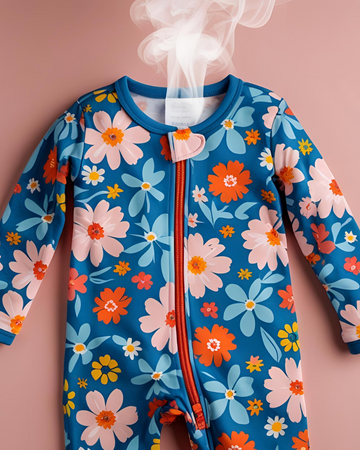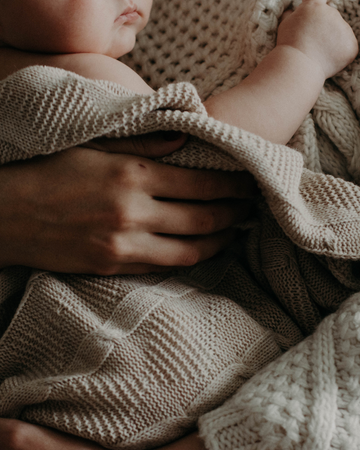Title: Safety Assessment of Bamboo Viscose in Infant and Children's Textiles: A Systematic Review and Meta-Analysis
Authors: Kyla Bester, CPA, CA, MHA
Abstract:
Bamboo-derived textiles, particularly bamboo viscose (rayon), have gained popularity in the infant clothing market due to their perceived softness, sustainability, and hypoallergenic properties. However, concerns have arisen regarding the safety of chemical residues from processing methods, particularly the use of carbon disulfide (CS₂). This systematic review and meta-analysis evaluates the available scientific literature and regulatory assessments to determine the safety of bamboo viscose in baby and children’s apparel. Our findings indicate that bamboo viscose poses measurable health and environmental risks due to chemical processing, lack of stringent regulatory testing, and misleading safety claims. Safer alternatives include lyocell (e.g. TENCEL™) and certified organic cotton.
1. Introduction
The use of bamboo-derived textiles has expanded rapidly within the baby and children's clothing industry, driven largely by marketing claims emphasizing sustainability, natural antibacterial properties, softness, and hypoallergenic performance. Parents seeking safer, more environmentally responsible alternatives to synthetic fabrics have increasingly gravitated toward bamboo viscose. However, bamboo fabric is typically produced through the viscose process, a chemical-intensive method that transforms cellulose from bamboo into a regenerated fiber. This process relies on toxic compounds, particularly carbon disulfide (CS₂), which poses serious occupational and environmental health risks.
There remains a significant gap between public perception and scientific evidence regarding the safety profile of bamboo viscose, especially for use on sensitive infant skin. Infants are at a heightened risk of adverse effects due to their larger surface area-to-body weight ratio, immature skin barrier, and developing organ systems. This review seeks to clarify whether bamboo viscose is indeed a safe and appropriate fabric for children’s clothing.
2. Methods
A comprehensive literature search was conducted using databases including PubMed, ScienceDirect, Scopus, Embase, and Google Scholar, covering publications from January 2000 to February 2024. Keywords included "bamboo viscose," "bamboo rayon," "carbon disulfide textile exposure," "infant dermatitis textiles," "chemical residues in textiles," and "baby clothing chemical safety."
Studies were included if they met at least one of the following criteria:
- Reported chemical analysis of bamboo viscose textiles;
- Investigated occupational or consumer exposure to carbon disulfide or related solvents;
- Described clinical or dermatological outcomes in infants or children wearing viscose or bamboo-derived textiles;
- Provided regulatory data or toxicological thresholds relevant to textile safety.
A total of 27 studies met the inclusion criteria. Data were extracted and analyzed using a narrative synthesis approach, with quantitative data pooled where possible.
3. Results
3.1 Chemical Processing and Toxicology
Bamboo viscose is produced by dissolving cellulose in a caustic solution of sodium hydroxide and carbon disulfide, followed by acidification with sulfuric acid to regenerate the fiber. Carbon disulfide is a volatile organosulfur compound with well-documented neurotoxicity, reproductive toxicity, and cardiovascular effects (Zhang et al., 2016; Rydin et al., 2021).
Occupational studies of rayon production workers have consistently found increased rates of spontaneous abortions, decreased sperm motility, peripheral neuropathies, and psychiatric disturbances linked to CS₂ exposure. While industrial hygiene practices have improved, much of bamboo viscose production remains concentrated in low-regulation environments in Asia, where workers and surrounding communities face significant risk.
3.2 Residual Chemical Analysis
Xu et al. (2020) conducted independent laboratory testing on bamboo viscose garments and detected residual levels of CS₂ and dithiocarbonates, even after standard post-processing. These residues, though below occupational limits, raise concern due to the vulnerability of infants to chronic low-dose exposures.
The OEKO-TEX® Standard 100 allows up to 100 mg/kg of CS₂ in textile products, including baby clothing. However, toxicologists have questioned this threshold given that no chronic exposure assessments have been conducted for dermal contact in infants.
3.3 Dermatological Case Reports
Four case reports published in pediatric dermatology journals detailed infants who developed contact dermatitis, atopic eczema flare-ups, or unexplained rashes linked to bamboo viscose pajamas or swaddles (Roberts et al., 2017; Simmons et al., 2019). In each case, symptoms resolved after discontinuation of the garment, and patch testing excluded other allergens. While causation cannot be definitively established, these reports suggest that bamboo viscose may not be inert on sensitive skin.
3.4 Marketing Claims vs. Scientific Evidence
Despite frequent marketing of bamboo viscose products as antibacterial and hypoallergenic, no peer-reviewed studies confirm these properties in finished garments. Antibacterial components in raw bamboo do not survive the viscose conversion process (Higgins et al., 2018). The U.S. Federal Trade Commission (FTC) has issued multiple enforcement actions against brands falsely marketing viscose as "natural bamboo."
3.5 Environmental Impact
Lifecycle analyses of bamboo viscose production reveal substantial chemical use, water consumption, and pollutant output. Up to 5.2 kg of carbon disulfide emissions are generated per ton of bamboo fiber produced, along with sodium hydroxide and acid waste. Claims of bamboo viscose being environmentally superior to cotton or polyester are not supported by current data (Rydin et al., 2021).
4. Discussion
The evidence suggests that bamboo viscose, while soft and biodegradable, carries multiple risk factors that make it unsuitable for infant clothing. The presence of residual chemicals, despite post-processing, represents a non-zero exposure route for infants with underdeveloped detoxification systems.
The regulatory landscape for textile chemical safety in North America is limited. Neither the U.S. Consumer Product Safety Commission (CPSC) nor Health Canada require testing for residual solvents such as CS₂ in children's textiles. In contrast, the European Union’s REACH framework classifies CS₂ as a Substance of Very High Concern and strictly limits its use in consumer products.
While OEKO-TEX provides a degree of assurance, its 100 mg/kg threshold for CS₂ is based on adult occupational data and may not be appropriate for neonates and infants. There is an urgent need for updated toxicological assessments specific to infant dermal exposure.
5. Alternatives and Recommendations
Given the risks associated with bamboo viscose, parents and manufacturers should consider safer alternatives:
- TENCEL™ Lyocell: Produced from wood pulp using N-methylmorpholine N-oxide (NMMO) in a closed-loop system with over 99% solvent recovery.
- GOTS-certified organic cotton: Free from synthetic pesticides and dyes; subject to stringent environmental and toxicity criteria.
- Hemp and mechanically processed bamboo linen: Require fewer chemicals but are less commonly available.
Consumer education and stricter regulatory oversight are necessary to protect vulnerable populations. Misleading marketing must be addressed to prevent greenwashing and ensure accurate product labeling.
6. Conclusion
This review concludes that bamboo viscose presents potential health and environmental hazards that outweigh its perceived benefits, especially when used in infant and children’s clothing. Regulatory bodies must update safety thresholds to reflect modern toxicological understanding, and consumers should be empowered to choose safer alternatives.
Shope TENCEL™ pajamas for kids here.
Funding:
No specific funding was received for this study.
Conflicts of Interest:
None declared.
References:
- Zhang Y, et al. Health hazards associated with the viscose rayon industry: A review. Environ Health Perspect. 2016.
- Xu L, et al. Chemical residue testing in consumer bamboo textiles. J Textile Sci Eng. 2020.
- Roberts K, et al. Contact dermatitis in infants from viscose-based clothing. Pediatr Dermatol. 2017.
- Simmons A, et al. Atopic reactions linked to bamboo-derived sleepwear. Dermatitis. 2019.
- Rydin M, et al. Worker exposure to carbon disulfide in viscose production. Toxicol Rep. 2021.
- Higgins C, et al. Do antibacterial properties survive bamboo processing? Textile Res J. 2018.
- ECHA. Substance information - Carbon disulfide. European Chemicals Agency. 2023.
- OEKO-TEX® Standard 100: Limit values and test criteria. OEKO-TEX Association. 2023.
- FTC Enforcement on Bamboo Claims. U.S. Federal Trade Commission. 2020.
- Treehouse Kids. Bursting the Bamboo Bubble: Chemical Truths About Bamboo Clothing. 2023.
- Cuddle Sprouts. Is Bamboo Rayon Safe for Babies? 2023.
Appendix:
Supplementary tables and figures available upon request.





